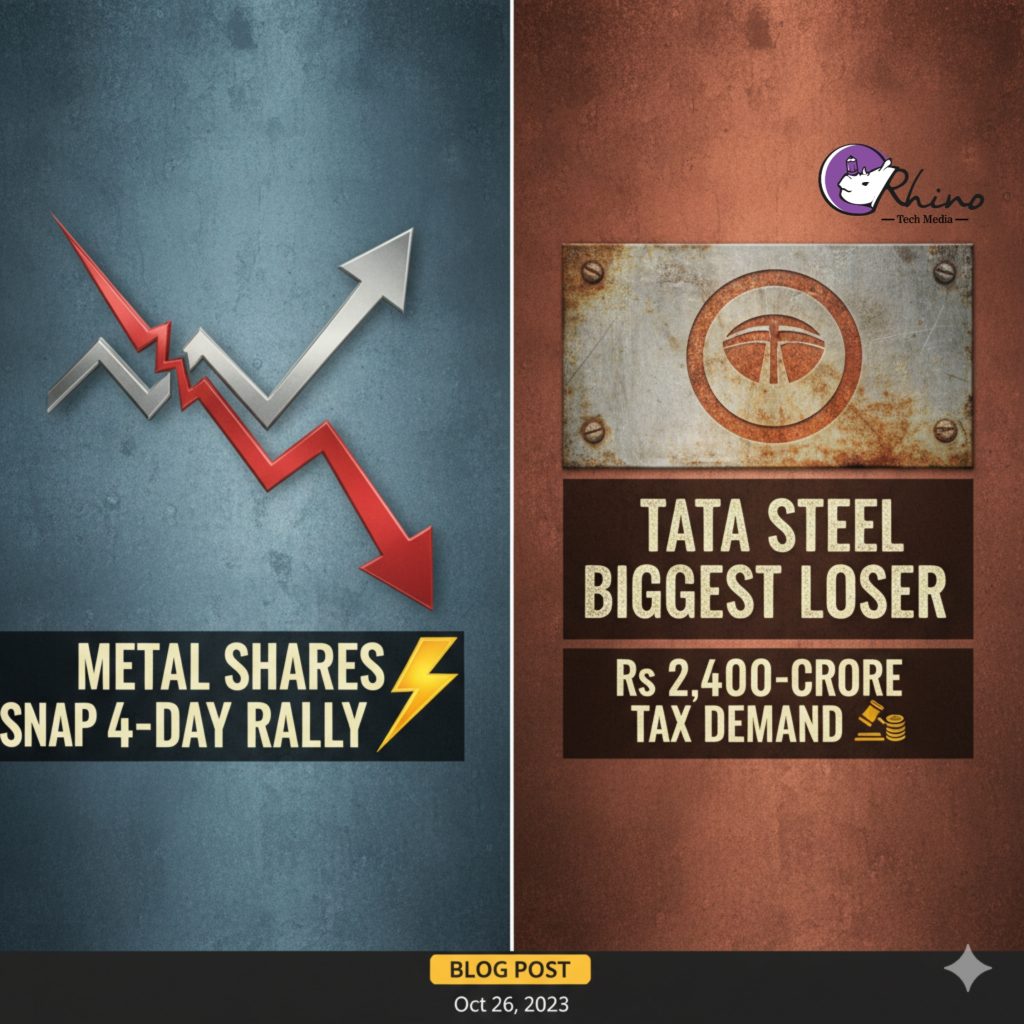Introduction
The Indian metal sector, which had been enjoying a sustained uptrend over the past few trading sessions, witnessed a sharp reversal as metal shares snapped a four-day rally. The selloff was triggered primarily by profit booking but was exacerbated by news that Tata Steel had received a large tax demand. Among metal counters, Tata Steel emerged as the sector’s biggest laggard, underscoring how a specific regulatory issue can derail broader sectoral momentum.
The Market Context: Rally, Reversal, and Sectoral Sentiment
In the days preceding the fall, metal stocks had been surging. Key drivers included a weakening U.S. dollar, expectations of interest rate cuts abroad, hopes for stronger global demand for commodities, and optimism over domestic infrastructure and capital expenditure pushing steel and metal demand. Analysts and market participants viewed India’s metals as well-positioned to benefit from tightening supply abroad (notably from China) and potential import curbs by trade authorities.
However, on the day in question, the upward momentum stalled. The Nifty Metal index turned into one of the worst performing sectoral indices, falling over 1 percent as investors began locking in profits. The reversal was not broad-based across all metal names, but it deeply impacted those already under scrutiny or those carrying regulatory or operational overhangs.
Tata Steel’s Tax Demand: Details and Implications
The key catalyst for the sharp underperformance of Tata Steel was a regulatory disclosure: the company announced that it had received a demand notice of about ₹2,410.89 crore from the Department of Mines, Jajpur (Odisha). The demand concerns an alleged shortfall in the dispatch of chromite ore from its Sukinda chromite block. Under the Mine Development & Production Agreement (MDPA) for that block, the company is said to have failed to meet specified dispatch obligations. The demand is based on the sale value of the shortfall quantity, in addition to appropriation of performance security.
Tata Steel, in its regulatory filing, stated that it believes the demand to be unjustified and that it has “adequate grounds to challenge the notice.” The company did not immediately foresee a material impact on its business operations from this demand.
It is worth noting that this is not the only regulatory demand the company is grappling with. Earlier, it had been served a show-cause notice for alleged irregular input tax credit claims of over ₹1,007 crore (pertaining to FY 2018-19 through FY 2022-23). Tata Steel had described that claim as lacking merit and not expected to have a significant impact on operations. The juxtaposition of multiple tax or regulatory overhangs places additional stress on investor confidence in the stock.
From a valuation perspective, such demands raise uncertainties not just about cash outflow but also potential reputational, legal, and compliance risks. Investors often apply a “regulatory discount” to stocks under such clouds, and in a sector already prone to cyclical swings, that discounting effect can be magnified.
The Fallout: Price Reaction and Sector Comparison
The immediate market reaction was punishing. Tata Steel shares fell over 2 percent on the day, making it the largest loser among Nifty constituents. Meanwhile, its peers in the metals/steel space — such as Steel Authority of India (SAIL), National Aluminium Company (NALCO), Hindalco, and Jindal Steel, among others — also posted losses, though the declines were more moderated. The metal index’s four-day winning streak came to a halt amid broad profit taking and spillover from the Tata Steel headline.
Interestingly, just a few sessions before the reversal, Tata Steel (alongside peers) had been a top gainer, riding the bullish sentiment. On October 3, for instance, Tata Steel had climbed over 3 percent with metal stocks broadly rallying.
Thus, the reversal demonstrates how fragile sectoral gains are when dependent on sentiment and how individual stock-level shocks can drag down the entire index.
Analysis: What Does This Episode Signify?
- Regulatory Risk in Commodity / Mining-Linked Firms
This episode is a stark reminder that firms dependent on natural resources, mining leases, or dispatch obligations are vulnerable to enforcement actions or retrospective demands. Even if such demands are contestable, the mere existence of a large claim introduces uncertainty and risk premium in valuations. - Investor Psychology & Overheating of Theme Plays
The metals sector had attracted heavy inflows in the preceding rallies. Gains built on momentum and expectations (dollar weakness, supply cuts overseas, protectionism) are vulnerable to sudden reversals when a negative news triggers profit booking. The Tata Steel demand acted as a trigger. - Differentiation in Peer Strength
Not all metal stocks reacted equally. Companies with cleaner regulatory records, better leverage, stronger balance sheets, or better growth visibility fared better. The event underscores the importance of stock selection even within a sectoral rally. - Longer-Term Outlook Still Intact (with caveats)
The structural tailwinds for the metals sector — infrastructure spending, urbanization, decarbonization (steel, aluminum demand), supply constraints internationally — remain valid. However, cyclical downturns and idiosyncratic risks (like this tax demand) will continue to periodically test valuations. - Need for Clarity and Disclosure
For Tata Steel, the management’s next moves will matter a lot. How it contests the demand, provides clarity on quantum and timing, and reassures investors about capital allocation and liquidity will be critical to stabilizing investor sentiment.
Conclusion
The abrupt snapping of the metals rally, with Tata Steel suffering the brunt, is a telling lesson in market dynamics: themes and tailwinds draw attention, but stock-specific challenges and regulatory overhangs can swiftly redefine narratives. While the broader metals outlook might still hold promise, investors are reminded that the devil often lies in the details — and that in capital markets, even ₹2,400-₹2,500 crore demands cannot be brushed off when they surface at a critical juncture.

